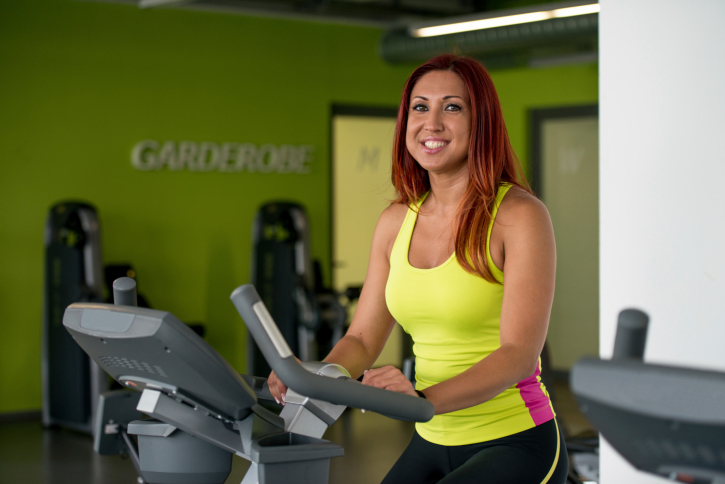Not enough hours in the day to fit in your workout? Want to know how to be more efficient in your exercise routine and give your body what it needs? Consider giving circuit training a try!
Circuit training is short bursts of resistance exercise using moderate weights and frequent repetitions, followed quickly by another burst of exercise targeting a different muscle group. Because the exercises switch between muscle groups, the rest you need between activities is limited, which helps keep your heart rate up. Peppering in some aerobic activities, like running or jumping rope, is a good way to further boost your heart rate in between exercises.
What you are aiming for in your circuit session is targeting all of the muscle groups of your body. The beauty of circuit training is that you can tailor your circuit to your fitness level. There are different approaches to circuit training:
- Example based on time: 1 minute jumping rope, 20 second rest, 1 minute doing crunches…
- Example based on repetitions: 10 push-ups, 10 jumping jacks, 20 crunches…
You can modify the intensity of your circuit by increasing or decreasing the amount of rest in between each exercise:
- More intense circuit: less time to rest in between exercises
- Less intense circuit: more time to rest in between exercises
Circuits include both cardio and strength training movements to make your workout more complete.
Cardio movements such as jumping rope, jumping jacks, plyometric movements, and running on the treadmill will keep your heart rate up.
Strength training movements such as body weight or using other exercise equipment (free weights, machines, medicine balls, kettlebell, etc) is going to allow you to improve your strength and help you maintain and even increase your muscle mass.
How long do these workouts have to be? Do you have 10 minutes? You will be amazed by how much you can improve your fitness levels and see results by investing as little as 10 minutes per day.
Want to try? Here are some examples of circuit workouts that you can do:
Circuit Example #1
Jump rope circuit (~10 minutes)
*take no longer than 20-30 seconds between exercises. This circuit can be modified by increasing the amount of time spent executing the exercises.
- 1 minute jump rope
- 30 seconds of push-ups (you can use your knees to fit your current fitness level)
- 1 minute jump rope
- 30 seconds holding a frontal plank
- 1 minute jump rope
- 30 seconds holding a side plank (right)
- 1 minute jump rope
- 30 second holding a side plank (left)
- 1 minute jump rope
- 30 seconds mountain climbers
- 1 minute jump rope
- 30 seconds superman position (on the ground, facing down, straight arms and legs off the ground for the whole 30 seconds)
- 1 minute jump rope
- Walk around for 2 minutes to cool down
- Stretch and you are done!
Circuit Example #2
Do 15-20 repetitions in a row, then move to the next exercise.
Standing Calf Raise: Focus on your posture during this exercise, pushing off with your heels but make sure the pads of your feet remain on the ground. Flex your calves as you go up and down. Always keep your stomach engaged (tight).
Floor Bridges: Do 10 repetitions (slow and controlled movements) and on repetition number 10, hold the position for 10 seconds, and do 10 more repetitions (yes, again!). That will be counted as one set. Focus on getting your hips in the air as high as you can (using your glutes and hamstrings). Move to the next exercise.
Step-Ups: Look for a box, chair, or step that you feel comfortable stepping up on, and make sure it is stable. Step up and down using the same leg with a slow-controlled movement, keeping your core engaged. Do 12-15 repetitions for each leg (that would be one set). Don’t let yourself drop to the ground going down, and make sure that when you are going up, you are engaging your core muscles and standing tall (elegant posture). Push your body upwards instead of forwards to avoid pushing your knee beyond the point where your toe is (this will protect your knee). Move to the next exercise.
Standing Side Leg Lifts: Focus on keeping your leg straight and your feet flexed (your toe should be pointing forward). Each movement should be slow and controlled. Do 15 repetitions for each leg. Move to the next exercise.
Wall squats: Place your back against a wall and start lowering yourself down until your thighs are parallel to the ground and your hip and legs are creating a 90 degree angle. Feet should be shoulder width apart and your arms should be next to your hips or up in the air (no hands on thighs!) Hold that position for 30-60 seconds.
Push-ups: Do 10-15 repetitions. You can use your knees to adapt them to your current fitness levels. Make sure that your core is engaged, and do not arch your back. Then start the circuit again, doing the first exercise of this routine.
You should do 4 sets of all the exercises, then stretch—and you are done!
These are basic examples of what a circuit exercise can look like. You can always tailor them to your fitness levels by adjusting the time you spend on each exercise or reducing the amount of exercises in the circuit. Also, for beginners, build your circuit based on exercises you actually enjoy doing—this will help you successfully complete your circuit. And remember, even if you can only invest 10 minutes of your day to exercise, it is better than not doing anything at all. Your body will thank you!
If you’re a Health Advocate member with access to the Wellness Coaching program, reach out to your Wellness Coach for more ideas on how to keep up your exercise program during the holiday season. And from all of us at Health Advocate, we hope you and your family have a happy, healthy holiday!



